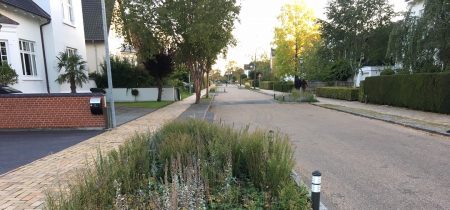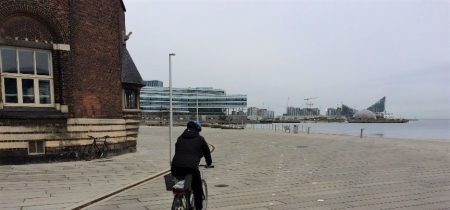Right of way intersections
Right of way intersections should make road users clearly aware of where they should go. It’s a good idea to reduce speeds at crossings. Set- back cycle tracks are another solution that can be applied to two-way cycle tracks at right of way intersections.
By Troels Andersen
There are three types of right of way intersections without traffic lights:
- Yield to the right intersections, where road users must yield to traffic coming from the right.
- Duty to yield intersections where the road user from a side rode must give way to cross traffic on the primary road.
- Intersections with stop signs.
The traffic safety effect of stop signs is approx. 10 times greater than duty to yield. Both stop signs and yield to the right intersections are rare in Denmark. Duty to yield is better than yield to the right because yield to the right results in more accidents. Some road users overlook yield to the right while others find the rule confusing. Yield to the right is much more widespread abroad. One solution is to change yield to the right to duty to yield.
The most frequent type of cyclist accident in right of way intersections are crossing collisions and left turn accidents. Serious accidents largely occur when the cyclist crosses the primary road.
Visibility and right of way
It is crucial that the right of way rules at an intersection are extremely clear. This can be done with markings, median islands, and unambiguous traffic calming measures such as crossings. The field of vision at an intersection depends on curves, planting, lighting, etc. The field of vision at intersections is crucial to the traffic safety of all road user groups. It is important that the field of vision is the same in both directions since otherwise road users concentrate their attention on the direction with poor line of sight and forget to look the other way.
Parked cars close to the intersection can make it difficult for road users to survey the traffic. This can be problematic for road users on side roads as well as road users on the primary road. Cyclists on the primary road should be visible at least 20 m before the intersection to side road users as well as drivers turning left from the primary road. In case of a downhill incline on the primary road the distance should be greater, for example 24 m at 20% and 30 m at 50%. This may also affect parking options up to the intersection.
The intersection should be recognizable in advance. Be aware that buildings, planting, and parked cars can be perceived as an uninterrupted line along the road, which makes it difficult to recognize an intersection. The intersection’s visibility can be improved by parking prohibitions, and interruptions in the planting and markings.
The verge between the cycle track and the traffic lane should be shortened well in advance of the intersection, partly to make cyclists more visible and partly to ensure optimal field of vision from the side road.
It’s difficult to turn left at large right of way intersections, for example when the primary road has four lanes. There is a relatively large risk that left turning drivers will overlook cyclists. Markings can remind drivers of the presence of cyclists, but there are also other solutions such as roundabouts and signalization.
Continuous cycle track
At intersections with little traffic on the side road, the cycle track should be continued through the intersection. A continuous cycle track has a traffic calming effect on motor vehicles coming from the side road since they have to cross the pavement and often the cycle track as well. The crossing makes it easier for side road users to recognize and understand who has the right of way. In a study of cyclist safety at smaller intersections it was additionally found that the number of cycling accidents dropped by about 50% when side road crossings such as a continuous cycle track and/or a pavement were established. A more recent study showed a drop of up to 25% in cycling accidents as well as many benefits for pedestrians.

- A safe, easy to understand crossing with a shortened cycle track and continuous pavement. Photo Troels Andersen
In order to make the cycle track more visible through the intersection it can be laid down in another surface or marked with bicycle symbols. Behaviour studies show that driver and cyclist awareness of each other is increased by establishing white cycle symbol patterns through the intersection. This requires dispensation, however.
Shortened cycle track
At intersections with more traffic on the side roads the cycle track may be shortened before the intersection. A shortened cycle track is more dynamic so turning road users drive faster. On the other hand cyclists and cars are on the same level in the intersection, which may raise awareness among both parties.
A shortened cycle track may be reinforced with a cycle crossing through the intersection to make it clear that this is a cyclist area. If there is a high accident risk for cyclists and moped drivers the cycle crossing can be applied as a blue cycle crossing.

- Blue cycle crossings on right of way cycle track. Photo: Troels Andersen
At right of way intersections in open country, the cycle track is almost always shortened. Right turn lanes should be avoided because right turning cars block side road users’ field of vision. However, when there is considerable right turning traffic, right turn lanes can be established with white markings or a traffic island can be installed between the right turn lane and the traffic lane. The verge should be removed at such intersections.
A shortened cycle track continued into a right turn lane is not generally recommended for right of way intersections. Instead, turning road users from the primary road should turn right at a very low speed. However, there are a couple of good examples of shortened cycle track in a right of way intersection with high cycling speeds.
Cycle lanes
When a cycle lane along the primary road continues up to the intersection, a cycle crossing through the intersection should be established. An accident analysis of cycling accidents in right of way T- intersections in an urban area shows that the accidents were mitigated when an existing cycling solution was continued through the intersection as a cycle crossing. To prevent squeezing between cyclists and cars the cycle lane can be installed by a 30 cm wide profiled stripe on the last segment up to the intersection. A continuous pavement will improve cyclist safety.

- Set- back cycle track. The curve at the intersection means that cyclists can ride no faster than 20 km/h, and cars have a waiting area outside the cycle track. Photo: Troels Andersen
Set- back cycle tracks
At intersections with heavy traffic on the primary road it’s a good idea to set the cycle track 5-7 m back from the road and lead the track across the side road on a raised surface. The set-back track makes it easier for road users to and from the side road to assess the potential risk of conflict with cyclists and gives them a better field of vision over the intersection. The set-back distance should be 5-7 m so an ordinary car can wait without getting in the way of other traffic. The raised surface is necessary to make drivers observe their duty to yield and keep them from stopping on the cycle track. If this solution is chosen it must be made clear to drivers that they must give way.
Set back cycle tracks should not be installed where there are many lorries on the side road since they cannot stop in the waiting area outside the track.
Mixed traffic
In mixed traffic it’s a good idea to establish crossings across side roads by continuing the pavement through the intersection. In addition, the curve radius should be relatively small. Pavement crossings don’t seem to have any effect on cyclist safety, but have a highly positive impact on pedestrian safety.
Two-way cycle tracks
Two-way cycle tracks and right of way intersections are a bad combination. There are safety issues which are difficult to solve if the track runs along the primary road. The issues are less difficult if the track is on the side road and crosses a primary road.
When two-way cycle tracks on primary roads have been chosen, it’s important to make the potential conflict very clear to both cyclists and drivers. Two-way cycle tracks should always continue all the way to the intersection.
Space permitting, the cycle track can be set back 5-7 m from the primary road and cross the side road on a raised surface. The other option is to lead the track 30-40 m away from the primary road and make cyclists give way at the intersection. That means that cyclists must yield to all traffic on the side road. This solution is not very cyclist friendly, but may be necessary for safety reasons or for motor traffic accessibility. Setting the track back 30-40 m is necessary since it’s impossible for cyclists at the intersection to survey the traffic in all directions at once. However, there are intersections where a 10-15 m setback has proved sufficient.
Traffic calming
The intersection can also be installed on a raised surface. However, it is uncertain whether raised surfaces affect cyclist safety.
Raised right of way intersections may mean that the right of way rules are unclear. Therefore it’s important to mark duty to yield.
Traffic calming islands on side roads particularly in rural areas make it easier for road users to understand the intersection.
Sources
Søren Underlien Jensen, Trafitec (2006): Effekter af overkørsler og blå cykelfelter.
Nielsen, Michael Aakjer (1994): Nye afmærkninger på cykelstier ved ikke signalregulerede T-kryds – Effektundersøgelse, Notat 8, Vejdirektoratet.
Lund, Belinda la Cour (1999): Cyklisters sikkerhed i kryds – Forslag til nye design af vigepligtsregulerede T-kryds, Vejdirektoratet.
Søren Underlien Jensen, Trafitec (2006): Fodgængeres og cyklisters oplevede serviceniveau på vejstrækninger.








